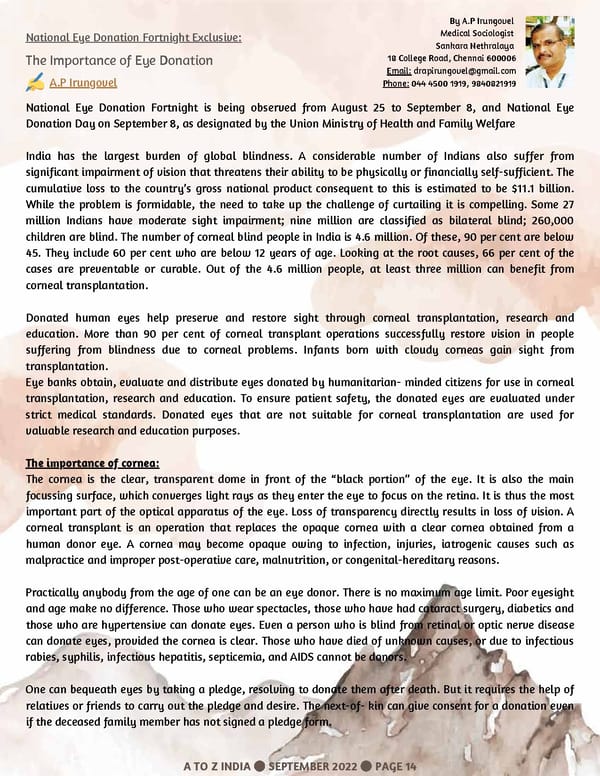By A.P Irungovel National Eye Donation Fortnight Exclusive: Medical Sociologist Sankara Nethralaya The Importance of Eye Donation 18 College Road, Chennai 600006 Email: [email protected] A.P Irungovel Phone: 044 4500 1919, 9840821919 National Eye Donation Fortnight is being observed from August 25 to September 8, and National Eye Donation Day on September 8, as designated by the Union Ministry of Health and Family Welfare India has the largest burden of global blindness. A considerable number of Indians also suffer from significant impairment of vision that threatens their ability to be physically or financially self-sufficient. The cumulative loss to the country’s gross national product consequent to this is estimated to be $11.1 billion. While the problem is formidable, the need to take up the challenge of curtailing it is compelling. Some 27 million Indians have moderate sight impairment; nine million are classified as bilateral blind; 260,000 children are blind. The number of corneal blind people in India is 4.6 million. Of these, 90 per cent are below 45. They include 60 per cent who are below 12 years of age. Looking at the root causes, 66 per cent of the cases are preventable or curable. Out of the 4.6 million people, at least three million can benefit from corneal transplantation. Donated human eyes help preserve and restore sight through corneal transplantation, research and education. More than 90 per cent of corneal transplant operations successfully restore vision in people suffering from blindness due to corneal problems. Infants born with cloudy corneas gain sight from transplantation. Eye banks obtain, evaluate and distribute eyes donated by humanitarian- minded citizens for use in corneal transplantation, research and education. To ensure patient safety, the donated eyes are evaluated under strict medical standards. Donated eyes that are not suitable for corneal transplantation are used for valuable research and education purposes. The importance of cornea: The cornea is the clear, transparent dome in front of the “black portion” of the eye. It is also the main focussing surface, which converges light rays as they enter the eye to focus on the retina. It is thus the most important part of the optical apparatus of the eye. Loss of transparency directly results in loss of vision. A corneal transplant is an operation that replaces the opaque cornea with a clear cornea obtained from a human donor eye. A cornea may become opaque owing to infection, injuries, iatrogenic causes such as malpractice and improper post-operative care, malnutrition, or congenital-hereditary reasons. Practically anybody from the age of one can be an eye donor. There is no maximum age limit. Poor eyesight and age make no difference. Those who wear spectacles, those who have had cataract surgery, diabetics and those who are hypertensive can donate eyes. Even a person who is blind from retinal or optic nerve disease can donate eyes, provided the cornea is clear. Those who have died of unknown causes, or due to infectious rabies, syphilis, infectious hepatitis, septicemia, and AIDS cannot be donors. One can bequeath eyes by taking a pledge, resolving to donate them after death. But it requires the help of relatives or friends to carry out the pledge and desire. The next-of- kin can give consent for a donation even if the deceased family member has not signed a pledge form. A TO Z INDIA SEPTEMBER 2022 PAGE 14
 A TO Z INDIA - SEPTEMBER 2022 Page 13 Page 15
A TO Z INDIA - SEPTEMBER 2022 Page 13 Page 15